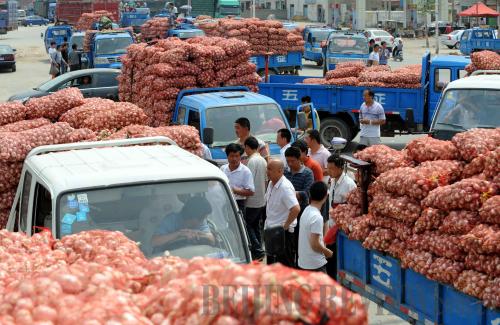|
 |
|
DEAR GARLIC: Garlic dealers came from all over the country to the garlic trading market in Jinxiang County in Shandong Province on June 1. Speculative dealers have pushed up wholesale prices of garlic in China (FAN CHANGGUO) |
Recent price hikes of various farm produce are quickly fueling inflation expectations across China. Even sideline products such as garlic and mung beans have become indicators of inflation. But why are these price hikes occurring in the first place? And what measures are being taken to stabilize them? Peng Sen, Vice Minister of the National Development and Reform Commission (NDRC), answered these questions in an interview with Xinhua News Agency. Edited excerpts follow:
What are the major farm products affected by this round of price hikes?
Peng Sen: Prices of some farm products have soared since the end of last year, including rice, corn, vegetables, garlic and mung beans. At first, it was the extreme weather including drought and low temperatures that caused price hikes for rice and vegetables. Then in March and April, speculators cornered herbal medicine ingredients such as sanqi and seed of Job's-tears. The purchasing price of sanqi hit a record high of 660 yuan ($96.6) per kg from 120 yuan ($17.57) per kg in 2009. Now it has fallen to 460 yuan ($67.3) per kg, due to investigation and intervention by price regulators in Guangdong and Yunnan provinces.
Since the end of April, speculators set their eyes on dried garlic and mung beans, pushing the retail price for dried garlic to 16 yuan ($2.4) per kg. But the garlic price began falling in May and has settled at 4 yuan ($0.6) per kg, because garlic produced this year became available at the market. The price for mung beans even skyrocketed to more than 20 yuan ($2.92) per kg in some supermarkets. It's unbelievable.
Price fluctuations for farm produce happen all the time, but why is this round of price hikes so steep?
We believe the supply-demand imbalance has contributed to the price hikes. On one hand, planting areas in the suburbs diminished quickly during China's fast industrialization and urbanization process and have affected the supply of farm produce. On the other hand, demand for grain, vegetables and meat has increased as a large number of farmers, who used to produce such products, have become consumers of those products while working as migrant workers in urban areas. In addition, as a result of diminishing planting areas in the suburbs, large cities now rely on farmers in other regions. This has contributed to increasing transportation and labor costs, as reflected in vegetable prices.
But these long-term factors will only lead to slow price increases, not short-term price hikes. Dealers with speculative motives, in addition to this year's extreme weather—such as drought in southwest China and lasting low temperature in central and east China—have pushed prices of certain farming goods to an unreasonable level.
Why was this timing special for speculators? Why were these varieties favored?
The property and stock markets absorbed large quantities of liquidity last year. But following a string of measures aimed to cool down the property market, excess cash of a speculative nature that withdrew from the stock and property markets had to look for new targets.
Except for rice and vegetables, the targets of speculative dealers are generally sideline and seasonal products that enjoy all-year but comparatively small demand. With limited supply, they are easy to stock up and speculate with. In contrast, grain is in a better position to cushion the impact of relevant speculations with huge national reserves.
What are the challenges this round of price hikes pose to the Central Government's management of inflation expectations?
While adding to the living costs of urban residents, farm produce price hikes are not necessarily a benefit for farmers. Therefore, stable produce prices are conducive to easing burdens on consumers, maintaining balanced agricultural production and quenching inflationary expectations.
| 